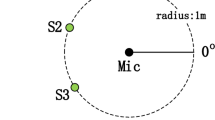Abstract
Our work applies a unifying Bayesian-Independent Component Analysis (BICA) framework in the context of speech enhancement and robust Automatic Speech Recognition (ASR). The corrupted speech waveform is reshaped in overlapping speech frames, and is assumed to be composed as a linear sum of the underlying clean speech and noise. Subsequently, a linear sum of latent independent functions is proposed to span each clean frame. Two different techniques are applied following a Bayesian formulation: In the first case the posterior probability of a clean speech frame is formed conditioned on the noisy one on which a maximum a posteriori (MAP) approach is applied, leading to Sparse Code Shrinkage (SCS) - a fairly new statistical technique originally presented to applied mathematics and image denoising, but its much promising potential for speech enhancement has not yet been exploited. In the second case, viewed within the Variational Bayes framework, the model for noisy speech generation is stated in a block-based fashion as a noisy, blind source separation problem from which we infer the independent basis functions that span the space of a speech frame and their mixing matrix, thus reconstructing directly the corresponding clean frames.
Preview
Unable to display preview. Download preview PDF.
Similar content being viewed by others
References
Deller, J., Proakis, G., Hansen, J.: Discrete Time Processing of Speech Signals. New York, Macmillan Publishing Company (1993)
Bell, A.: The Independent Components of Natural Scenes are Edge Filters. Vision Research (1997) 3327–3338
Hyvärinen, A., Hoyer, O., Oja, E.: Image Denoising by Sparse Code Shrinkage. S. Haykin and B. Kosko (eds), Intelligent Signal Processing, IEEE Press, (2000)
Hyvärinen, A., Oja, E.: A Fast Fixed-Point Algorithm for Independent Component Analysis. Neural Computation, 9(7) (1997) 1483–1492
Miskin, J., MacKay, D.: Ensemble Learning for Blind Source Separation. Principles and Practice, Cambridge University Press
Attias, H.: Independent Factor Analysis. Neural Computat., (11) (1999) 803–851
Ghahramani, Z.: On Structured Variational Approx., Techn. Report CRG-TR-97-1
Author information
Authors and Affiliations
Editor information
Editors and Affiliations
Rights and permissions
Copyright information
© 2001 Springer-Verlag Berlin Heidelberg
About this paper
Cite this paper
Potamitis, I., Fakotakis, N., Kokkinakis, G. (2001). Bayesian Independent Component Analysis as Applied to One-Channel Speech Enhancement. In: Dorffner, G., Bischof, H., Hornik, K. (eds) Artificial Neural Networks — ICANN 2001. ICANN 2001. Lecture Notes in Computer Science, vol 2130. Springer, Berlin, Heidelberg. https://doi.org/10.1007/3-540-44668-0_83
Download citation
DOI: https://doi.org/10.1007/3-540-44668-0_83
Published:
Publisher Name: Springer, Berlin, Heidelberg
Print ISBN: 978-3-540-42486-4
Online ISBN: 978-3-540-44668-2
eBook Packages: Springer Book Archive




